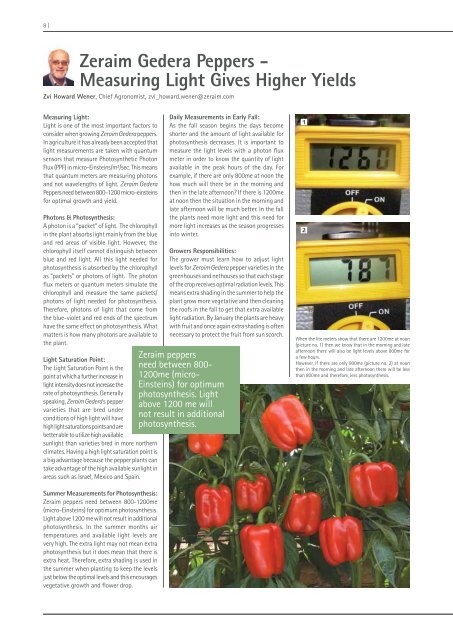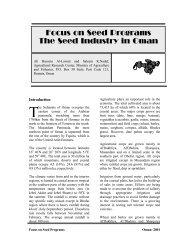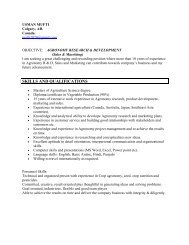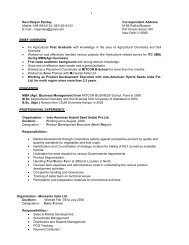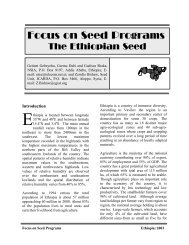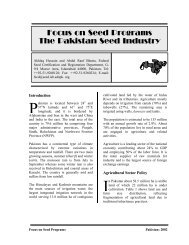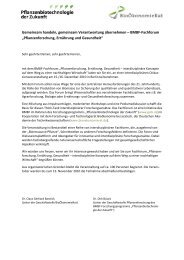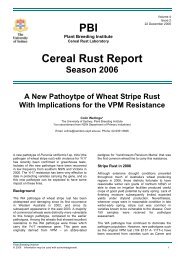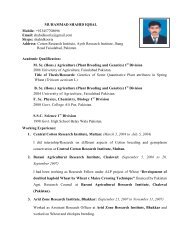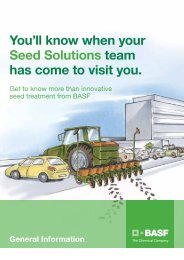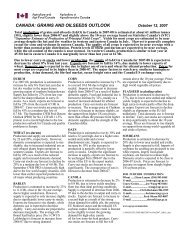Download newsletter - SeedQuest
Download newsletter - SeedQuest
Download newsletter - SeedQuest
You also want an ePaper? Increase the reach of your titles
YUMPU automatically turns print PDFs into web optimized ePapers that Google loves.
8 |<br />
Zeraim Gedera Peppers -<br />
Measuring Light Gives Higher Yields<br />
Zvi Howard Wener, Chief Agronomist, zvi_howard.wener@zeraim.com<br />
Measuring Light:<br />
Light is one of the most important factors to<br />
consider when growing Zeraim Gedera peppers.<br />
In agriculture it has already been accepted that<br />
light measurements are taken with quantum<br />
sensors that measure Photosynthetic Photon<br />
Flux (PPF) in micro-Einsteins/m²/sec. This means<br />
that quantum meters are measuring photons<br />
and not wavelengths of light. Zeraim Gedera<br />
Peppers need between 800-1200 micro-einsteins<br />
for optimal growth and yield.<br />
Photons & Photosynthesis:<br />
A photon is a “packet” of light. The chlorophyll<br />
in the plant absorbs light mainly from the blue<br />
and red areas of visible light. However, the<br />
chlorophyll itself cannot distinguish between<br />
blue and red light. All this light needed for<br />
photosynthesis is absorbed by the chlorophyll<br />
as “packets” or photons of light. The photon<br />
flux meters or quantum meters simulate the<br />
chlorophyll and measure the same packets/<br />
photons of light needed for photosynthesis.<br />
Therefore, photons of light that come from<br />
the blue-violet and red ends of the spectrum<br />
have the same effect on photosynthesis. What<br />
matters is how many photons are available to<br />
the plant.<br />
Light Saturation Point:<br />
The Light Saturation Point is the<br />
point at which a further increase in<br />
light intensity does not increase the<br />
rate of photosynthesis. Generally<br />
speaking, Zeraim Gedera’s pepper<br />
varieties that are bred under<br />
conditions of high light will have<br />
high light saturations points and are<br />
better able to utilize high available<br />
sunlight than varieties bred in more northern<br />
climates. Having a high light saturation point is<br />
a big advantage because the pepper plants can<br />
take advantage of the high available sunlight in<br />
areas such as Israel, Mexico and Spain.<br />
Daily Measurements in Early Fall:<br />
As the fall season begins the days become<br />
shorter and the amount of light available for<br />
photosynthesis decreases. It is important to<br />
measure the light levels with a photon flux<br />
meter in order to know the quantity of light<br />
available in the peak hours of the day. For<br />
example, if there are only 800me at noon the<br />
how much will there be in the morning and<br />
then in the late afternoon? If there is 1200me<br />
at noon then the situation in the morning and<br />
late afternoon will be much better. In the fall<br />
the plants need more light and this need for<br />
more light increases as the season progresses<br />
into winter.<br />
Growers Responsibilities:<br />
The grower must learn how to adjust light<br />
levels for Zeraim Gedera pepper varieties in the<br />
greenhouses and nethouses so that each stage<br />
of the crop receives optimal radiation levels. This<br />
means extra shading in the summer to help the<br />
plant grow more vegetative and then cleaning<br />
the roofs in the fall to get that extra available<br />
light radiation. By January the plants are heavy<br />
with fruit and once again extra shading is often<br />
necessary to protect the fruit from sun scorch.<br />
Zeraim peppers<br />
need between 800-<br />
1200me (micro-<br />
Einsteins) for optimum<br />
photosynthesis. Light<br />
above 1200 me will<br />
not result in additional<br />
photosynthesis.<br />
When the lite meters show that there are 1200me at noon<br />
(picture no. 1) then we know that in the morning and late<br />
afternoon there will also be light levels above 800me for<br />
a few hours.<br />
However, if there are only 800me (picture no. 2) at noon<br />
then in the morning and late afternoon there will be less<br />
than 800me and therefore, less photosynthesis.<br />
Summer Measurements for Photosynthesis:<br />
Zeraim peppers need between 800-1200me<br />
(micro-Einsteins) for optimum photosynthesis.<br />
Light above 1200 me will not result in additional<br />
photosynthesis. In the summer months air<br />
temperatures and available light levels are<br />
very high. The extra light may not mean extra<br />
photosynthesis but it does mean that there is<br />
extra heat. Therefore, extra shading is used in<br />
the summer when planting to keep the levels<br />
just below the optimal levels and this encourages<br />
vegetative growth and flower drop.


